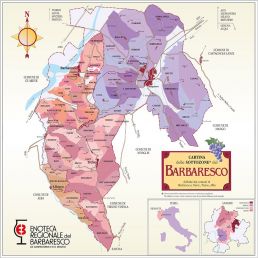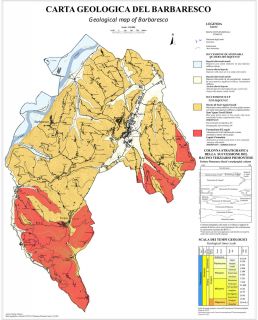THE MUNICIPALITIES
The area of origin of Barbaresco is made up of just 4 municipalities: Alba (only for the hamlet of San Rocco Seno d’Elvio, on the right side of the stream), Barbaresco, Neive and Treiso for the entire municipality.
There are also limits about altitude and exposure that point out the most suited areas. It is forbidden to plant it in the North, as well as in the valleys and in the flat lands.
The 763.19 acres that make up the production area are divided as follows: 249.19 hectares in Barbaresco, 280.62 hectares in Neive, 46.49 hectares in San Rocco Seno d’Elvio and 186.89 hectares in Treiso.
THE GEOLOGY
From a geological point of view the Barbaresco area is not fundamentally different from the Barolo area.
The whole Barbaresco area is of Miocene origin (that is, it belongs to the Tertiary or Cenozoic Era) and of marine formation, with the exception of alluvial areas of Holocene origin (Quaternary or Neo-Nozoic Era). The soil is mainly made up of calcareous marl, sedimentary deposits that climbed to the surface with the gradual lifting of the primordial sea bed that covered the Po basin.
Although the Barbaresco area is homogeneous, it can be divided into two parts according to the prevailing soil types.
The soils of Treiso, San Rocco Seno d’Elvio and Neive, south of the town centre, belong to the ” Formations of Lequio” (Tortoniano-Serravalliano), characterised by layers of compact grey marl alternating with layers of sand.
The soils of Barbaresco and the part of Neive that is leaning against Barbaresco belong to the ” Marne of Sant’Agata Fossili ” (Tortoniano), characterized by calcareous bluish marls.





